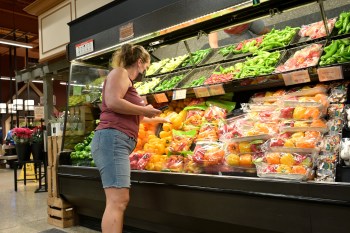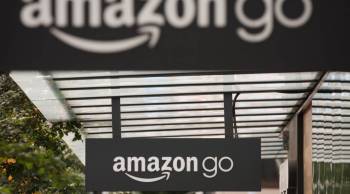Should we know how much stores take in from food stamps?
In recent years, the U.S. has spent more than 70 billion taxpayer dollars annually on food stamps, formally known as the Supplemental Nutrition Assistance Program. SNAP dollars go to millions of low-income Americans, who spend the money to buy food at stores across the country.
Big-box discount stores and large supermarkets take in the most food stamp dollars. At the same time, most of their employees earn little enough to qualify for food stamps themselves. The nation’s largest retailer, Wal-Mart, told investors it takes in about 18 percent of all SNAP spending, which would amount to an estimated $13 billion last year.
But the government has never disclosed how much individual companies take in from food stamp dollars.
The U.S. Department of Agriculture, which runs the food stamp program, has long argued it is required by law to keep the information private, because it amounts to a retailer’s trade secret. Now, the USDA is reconsidering.
Monday was the last day of a month-long public comment period set up by the USDA. A few hours before the deadline, nearly 500 comments had poured in from a range of voices in the food retail industry and beyond. Input has come from owners of large-supermarket franchises, gas station convenience stores, health food stores, farmers market managers, anti-hunger and nutrition advocates and private citizens.
You can read them all here. Below is a sampling:
I throw my full weight into supporting the release of retailer data concerning food stamps. As a publicly-funded support service, citizens deserve total transparency in what happens to that money, and especially if there’s the possibility that companies are profiting from the program. From the reports I’ve heard concerning Wal-Mart in particular, their employees who receive food stamp support are not only encouraged to then purchase products from Wal-Mart, their very employment at such low wages is made possible by receiving supplemental support.
This latter point mirrors the corporate welfare loophole that also occurs with health care coverage i.e. employees not making enough to have health insurance so they resort to publicly-funded emergency room treatment.
Wal-Mart’s only defense to releasing the data seems to be that they are afraid competitor companies could exploit said data to better target the market base in the area. So what’s on the scales here is, on the one hand, Wal-Mart’s business interest and on the other, the entire public’s interest.
Please side with democracy, transparency, and fairness, not the corporate favoritism that is going to erode our great country.
— Lisa Roiter, New York, NY
Seven-Eleven Hawaii is adamantly opposed to sharing our store SNAP sales information for various reasons.
1. Sales information of any type and for any company should be proprietary and not shared with other competitors or the general public.
2. The disclosure of SNAP sales or any sales information to our competitors would provide them with information that they are not entitled to have nor have they worked to build the clientele for the related sales.
3. All companies work continuously to increase their competitive advantage in the marketplace and should not be required to share their corporate intelligence with the competitors or the general public.
— Greg Hanna, Seven-Eleven Hawaii, Inc, Honolulu, HI
Aggregated annual/monthly SNAP redemption data at the individual store level is indeed confidential. Release of this data will harm the small stores in the following ways.
The big box store could use this data to target areas of potential growth. Studies have shown that when a big box store (Wal-Mart, Lowes, Home Depots, etc) I placed in a neighborhood the small businesses in the area goes out of business.
Small stores are already overburden with the amount of regulations that they have to report and follow. This is reporting requirement will add more cost to the small businesses. This cost will eventually be past down to the consumer. Small retailer in comparison to big box stores are already operating will slim profit margins. They do not need the added burden of this requirement.
For transparency, I would have no problem with the release of this data at the state level. This would protect the small retailer from the big box stores using this data to target their growth. The burden will also shift to the local FNS offices. They already have the data at hand and the small retailer do not have to worry over additional reporting requirements.
My store have been a SNAP authorized retailer for over twenty (20) years. Small retailer are the back bone of this country. It is the small retailer that hires the most people in comparison to the big box store. It is the small business that will have the greatest harm because of this requirement.
— Xavier Gallon, Carolina Market, Philadelphia, PA
I’m not as concerned about the public seeing this info as if anyone cares, but big competition could use that info to target smaller competitors like us as if we don’t already have a target on our backs.
— Randy Jackson, Rockdale Grocery, Conyers, GA
If retailers SNAP transparency impedes their business, that’s a problem they have to deal with internally. Tax payers support SNAP to aid their fellow citizens in need, not to aid SNAP authorized retailers make their bottom line. Their business models should not be reliant on SNAP benefits in the first place.
I think data per store is most useful. It’s always best to be as detailed as possible and there’s no reason to withhold details from the tax payers funding the SNAP program. Aggregated sales at all stores within a state or nationally should be provided in addition to per-store data. The public has a right to know where SNAP benefits are being spent at every level. How else would we be able to make informed decisions when we vote or reach out to our representatives about changes we’d like to see in SNAP benefits. Transparency is the only thing that can empower the public to make informed decisions.
I think it’s crazy this information was ever not available to any citizen who was interested.
— Bri Kapellas, Private Industry
The New York City Coalition Against Hunger stands in support of the United States Department of Agriculture in providing greater transparency in the release of data related to retailers and the Supplemental Nutrition Assistance Program (SNAP). The New York City Coalition Against Hunger agrees that the retail data that the USDA requests to be released to the public in the Food and Nutrition Act should be less restricted for transparency purposes.
In general, releasing of data and increasing transparency is in the interest of the public. The New York City Coalition Against Hunger supports the USDA as it strives for the production of more information that can be used to hold government accountable to the public, increase the trust between the government and public, allow the citizenry to be more educated, and allow the government to make better decisions about the peoples well-being, both at elections and at all other times.
Aggregated annual SNAP redemption data at the individual store level should not be considered confidential business information.
The amount of money that is spent by SNAP recipients is a sizable share of our economy. In 2013, alone, $76 billion were allotted to SNAP beneficiaries. Currently there are approximately 47 million Americans who spend an average of about $133 per person each month in SNAP benefits at grocery stores throughout the nation. While statistics are available for the demographics of the recipients of those SNAP benefits, the public does not have information on where the benefits are spent.
It is essential to understand and manage our food systems. There have long been links between poverty and obesity, and lack of access to affordable, nutritious food. If we know what people are purchasing with their EBT cards and where, we can link subsidies to healthy food to make it affordable and more accessible through the use of programs such as New York Citys HealthBucks which is used at farmers markets. Purchases can also be tracked, tabulated and linked to the USDAs food desert map so that tactics can be developed to bring more nutritious, affordable options to those who lack them.
In addition to those individuals whose diets are subsidized, stores that sell food products and accept EBT transactions profit directly from SNAP. The public has a right to know which corporations are the beneficiaries of this government money. When many grocery and other stores that accept SNAP have employees who earn wages that are low enough to be eligible for the government food assistance that they and their customers spend, it is in everyones interest to know the facts.
— Lisa Levy, NYC Coalition Against Hunger, New York, NY
Disclosing all benefits utilized in a retail establishment should be no problem. For the retailers that administer the program/benefits correctly and legally they have nothing to hide.
Complete transparency with regards to the SNAP benefits is encouraged as far as I am concerned.
As well as everyone receiving benefits should have to pass a random drug test to get or continue getting benefits.
— Roy Johnson, CJ’s Quick Stop, Jacksonville, TX
There’s a lot happening in the world. Through it all, Marketplace is here for you.
You rely on Marketplace to break down the world’s events and tell you how it affects you in a fact-based, approachable way. We rely on your financial support to keep making that possible.
Your donation today powers the independent journalism that you rely on. For just $5/month, you can help sustain Marketplace so we can keep reporting on the things that matter to you.


















